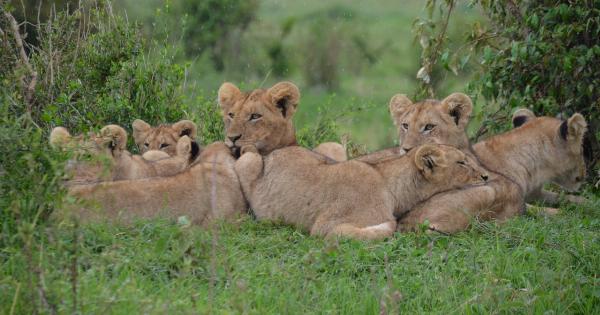In the vast African savannas, a society of lions once thrived, living together in harmony and embodying the true essence of companionship.
These majestic beings possessed an indomitable spirit and were respected by all other creatures in their territory. However, despite their strength and prowess, they faced an unexpected and relentless adversary – insects.
The Silent Threat
The society of lions found themselves slowly overwhelmed by an increasing population of insects. This creeping menace infiltrated their habitat and disrupted the delicate balance of their ecosystem.
These insects became a significant threat to the lions’ well-being, causing them to suffer from various diseases and discomforts.
A Battle for Survival
The lions, aware of the danger they faced, fought valiantly against the insects, using their powerful paws and razor-sharp claws to protect their territories.
Countless hours were spent trying to defend their pride and sustain their companionship within the society. However, as time passed, it became apparent that the insects were outpacing the lions’ efforts, leaving them exhausted and weakened.
An Unfortunate Decision
Desperate to restore balance to their habitat and alleviate the suffering of the society of lions, a difficult decision was made by conservationists.
It was concluded that euthanizing the lions was the most humane course of action, serving a dual purpose of ending their suffering while also preventing the relentless spread of insects to nearby regions.
The Final Goodbye
As the day of euthanasia approached, the air was heavy with sadness and grief. The society of lions, weakened but still displaying their regal grace, bid farewell to their companions and the habitat they had called home for generations.
The poignancy of the moment was palpable, as the once-mighty lions took their last steps with dignity and resignation.
Reflections on a Loss
The loss of the society of lions impacted not only those closely associated with their conservation but also the ecosystem as a whole.
These noble creatures played an essential role as apex predators, maintaining balance and preventing overpopulation of other species. With their absence, the ecosystem would inevitably witness widespread changes and potential imbalances.
The Ripple Effect
The impact extended beyond the immediate ecosystem. Tourists who once flocked to witness the magnificence of the society of lions now had no reason to venture into the savannas.
This sudden decline in tourism posed economic challenges to local communities, who relied on the revenue brought in by wildlife enthusiasts.
Lessons for Conservation
This heart-wrenching event serves as a reminder to conservationists and wildlife enthusiasts worldwide.
It highlights the urgency and importance of preserving ecosystems and addressing the unexpected challenges faced by vulnerable species, such as the society of lions. Efforts must be made to study and understand the intricate dynamics of these ecosystems to implement proactive measures.
A Call for Action
The tragic fate of the society of lions compels us to reflect on our individual responsibilities in safeguarding the natural world. We must support initiatives aimed at protecting and conserving vulnerable species and their habitats.
Our collective actions can ensure the survival and well-being of these remarkable beings, who rely on us as their stewards.
The Legacy Lives On
Although the society of lions may no longer grace the African savannas, their spirit lives on in the collective consciousness of humanity.
Their struggle against the insects and their ultimate sacrifice serves as a poignant reminder of the resilience and fragility of all species in the face of unforeseen challenges. May their story inspire generations to come to cherish and safeguard the wonders of our natural world.





























